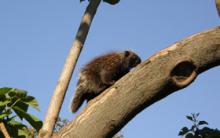The Caucasus is one of the largest mountain systems in the world. It occupies a huge area, and its peaks are the highest in our country - Elbrus, belonging to the Central Caucasus system, even surpasses the European Mont Blanc. The Western Caucasus is part of the Greater Caucasus and also has interesting characteristics.
Location and composition
The mountains of the Western Caucasus are part of the vast system of the Greater Caucasus, which stretches for more than 1 thousand km. In width, this mountainous country can exceed 150 km. The highest mountains of the system are located in the central part of the Caucasus. The mountains of the Western Caucasus lag behind in height, but they are distinguished by a high diversity of flora, fauna, and impressive views.
In addition to the western Caucasus, the Greater Caucasus is also divided into a central part and an eastern one. The territory of the Caucasus is located on a huge continental uplift, which exceeds the height of all the surrounding plains. The slopes of the mountains are composed of rocks of different ages, from the most ancient to the youngest. Ancient rocks come out where it depends on the geological processes of folding, mainly in the inner regions of the Caucasus. The outer slopes are composed of younger rocks.

The northwestern Caucasus received its present form as a result of modern geological processes. Glaciers play an important role in this, covering a significant area and feeding most of the local rivers.
In addition, glaciers contributed to the formation of modern landscapes - thanks to them, such types of formations as trough valleys, cirques, cirques, moraines appeared in many. Some of them are still filled with glaciers, while others below may contain glacial lakes with clear water.
Features of the Western Caucasus
The mountains of the Western Caucasus are part of such Russian regions as the republics of Adygea, Karachay-Cherkessia, as well as the Krasnodar Territory. On the territory of this mountain system there are several nature protection zones designed to protect rare and endangered species of animals and plants that are found only there, or preserved from ancient times.

The western part of the northern Caucasus is distinguished by an abundance of nival-glacial landscape types created by the passage of glaciers. Often in the valleys of this origin, there are lakes with crystal clear water. All rivers originating in these mountains are distinguished by great purity and transparency of water, since the amount of solid runoff is minimal.
The Western Caucasus is distinguished not only by the habitat there of many species of rare animals and plants, the very nature of this mountain system is striking in its grandeur and beauty. In these places you can see snow-capped mountains, gigantic trees, fast mountain rivers with impressive waterfalls.



The territory of the North-Western Caucasus corresponds to the territory of the Kuban and the Black Sea region and is approximately 87,000 thousand km2. The territory of the North-Western Caucasus lies within the following coordinates: in the north - about 47°N, in the south - 43°30'N, in the west - 36°E, in the east - 41°44 ' o.d. The length from north to south is about 400 km, and from west to east - about 360 km.
The nature of the Northwestern Caucasus is exceptionally diverse and rich. There are extensive black earth plains, wooded mountains with individual snowy peaks and Black Sea subtropics.
The climate in the Northwestern Caucasus is considered to be temperate continental, but this definition is very approximate, since there are a number of climatic zones in the mountains.
The area of excursions we offer is the Lagonaki Highlands, only a small part of the North-Western Caucasus between the Belaya and Pshekha rivers, but a geographically very interesting territory. Administratively, the highland is located in the Krasnodar Territory (Apsheron and Sochi districts) and the Republic of Adygea (Maikop district).
The Lagonaki Highlands unites all limestone ridges and massifs of the interfluve of the Belaya and Pshekha, drawing their borders along the cliffs of the Nagoi-Chuk massif and the Chernogorye plateau in the west, rocky ledges of the Stone Sea and Azish-Tau ridges in the east. The orographic node of the highlands is the mountain group of the Fisht massif. It is located in the very south of the described territory and is its highest part. It includes mountains Fisht (2868 m), Oshten (2804 m) and Pshekha-Su (2744 m). The highest point of the highlands - Mount Fisht - occupies the extreme southern position of the entire system. On the massif, glacial and karst landforms are developed, there are many caves. The array, arcuately covering the source of the Belaya River, forms a huge circus. On the slopes of the peaks of the massif, 540 plant species grow, of which about 22% (120 species) are endemic. The vegetation of subalpine and alpine meadows prevails. Woody vegetation (pine forests, fir forests, beech and birch crooked forests) is only on the southern slopes and at the foot of the massif. This is a remarkable and popular region of the North-Western Caucasus. Here is the lowest snow limit (2650 m) and the extreme western glaciers of the Caucasus. Tourist routes pass nearby, and on the banks of the Belaya River, at the foot of Mount Fisht, there is a tourist shelter. In clear weather, the entire Fisht-Oshtenovsky massif is clearly visible from Krasnodar (a straight line distance of 135 km).
The climate of the Lagonaki Highlands is formed under the influence of various factors, the most important of which are the geographical position and vertical zonality of the territory. Here one can trace the usual trend of decreasing average annual temperatures with height. Summer in the highlands is moderately cool in terms of temperature, which is a consequence of significant heights. The highest temperatures fall in July-August. The wind regime is subject to the peculiarities of the geography of the area. Wind speeds on the highlands are weakened. According to the Lago-Naki meteorological station, average monthly speeds of 1.5 - 2 m/s prevail, the lowest speeds are observed in July. Precipitation is unevenly distributed. In the general case, on the highlands, their number increases with height. The highest average annual rainfall, 2744 mm, was recorded at the Belorechensky Pass.
There are not many minerals in this part of the Northwestern Caucasus. The most significant of them are gas and oil. Currently, two oil and gas condensate fields are being exploited - Maykopskoye and Koshekhablskoye. Coal deposits are found in the Jurassic deposits, but the seams are not large from 45 to 70 cm. Their development is impractical. In the mountainous part of the Northwestern Caucasus, manifestations of ore mineralization of molybdenum, tungsten, barite, polymetals (lead, zinc, copper), as well as silver and gold are widespread. Both primary and alluvial (channel) gold is known here. There are many non-metallic minerals that can be used for the production of building materials (brick and expanded clay, sand, sand and gravel mixtures), ornamental stones (gypsum and anhydride), building and facing stones (limestone, dolomites, marble). There are mineral thermal (from +15° to 80° C) springs. Four springs are used for medicinal purposes; sanatoriums and hydropathic clinics have been built on their basis. Khan's source - medical-table hydrocarbonate sodium waters; Kurdzhipsky - medical-table hydrocarbonate chloride-sodium waters; Maikop - iodine-bromine highly mineralized waters and brines; Abadzekh - sulfide waters.
The main river of this area is the Belaya River. The beginning takes from the springs of Mount Oshten. The river flows into the Krasnodar reservoir near the village of Vasyurinskaya. The length of the river is 277 km. Total drop 2283m. Drainage basin 5990 sq. km. More than 4,000 tributaries flow into Belaya. The main tributaries of the Belaya: the right ones are Berezovaya, Kholodnaya, Teplyaki 1 and 2, Chesu, Molchepa, Kish with Bezymyannaya, Dakh, Fyunt, Maikopka; left - Zhelobnaya, Aminovka, Shuntuk, Kurdzhips, Pshekha. Belaya is powered by precipitation, in the form of snow and rain, groundwater, as well as high-altitude snowfields and glaciers. Belaya is high-water, it contributes an average of 3.4 billion cubic meters to the Kuban. m of water per year. Belaya crosses a number of different landscapes on its way, so the nature of the river changes from the upper reaches to the mouth. Initially, the Belaya River flows in a southeasterly direction along a longitudinal mountain valley, parallel to the Main Caucasian Range, consistent with the direction of folding, during the formation of the valley, the river used a longitudinal tectonic fault in the upper reaches. Then the river turns sharply to the north, breaking through the mountain ranges, and cuts into a cross strike layers of Jurassic and younger sediments. Where the Belaya washed out stronger rocks (granite, sandstones, limestones), it developed a canyon-like deep valley with steep slopes (Granite Canyon, Khadzhokhskaya gorge), and in less stable, including clay rocks, the river valley is expanded and bears a series of terraces (villages are located in such extensions). Moving along the river valley from the upper reaches to the lower reaches, one can trace how the rock strata gradually change from very ancient to the youngest, as if traveling through time from one geological epoch to another, younger one.
Yesterday, at the 43rd session of the UNESCO World Heritage Committee, without discussion, a decision was made on the inadmissibility of building natural sites "Western Caucasus" and "Golden Mountains of Altai" in Russia. However, environmentalists call these measures not tough enough. They hope that in 2020 UNESCO will present Russia with more serious requirements for the conservation of natural sites. Next year, an international organization is to assess the threat to Russia's five "most problematic" natural areas, for which Russian officials and companies have their own plans.
The meeting of the UNESCO World Heritage Committee has been held in Baku since the beginning of the week. Yesterday, an international organization issued decisions on several Russian World Heritage Sites. In particular, UNESCO welcomed the Russian side's confirmation that the planned Power of Siberia-2 gas pipeline (formerly the Altai project) would bypass the Golden Mountains of Altai facility (see Kommersant on March 4). However, this time the committee recalled its position: any decision to pass the gas pipeline through a protected area will be the basis for transferring it to the World Heritage List in Danger. In this regard, the organization asked to provide documents that would confirm the alternative route.
UNESCO also “noted with concern” that the Russian authorities did not provide information on the Maly Kalychak gold deposit in Gorny Altai, and asked for this to be corrected by February 1, 2020.
In its decision, the committee recalls that mining is incompatible with World Heritage status.
As Kommersant previously reported, the Ministry of Natural Resources announced that the license for gold mining near Lake Teletskoye had been suspended. However, according to the state register of subsoil plots and licenses, the contract for the use of the Maly Kalychak field is valid until 2027.
Also, UNESCO made a decision on the object "Western Caucasus". Recall that at last year's session, the international organization expressed concern about the plans of Russian companies to build mountain tourism infrastructure on the territory of the Sochi National Park and the Sochi Reserve. As Kommersant reported, Gazprom was exploring the possibility of laying ski slopes near the World Natural Heritage site (see Kommersant dated June 5, 2018). However, the Russian authorities reported: there are no plans to develop tourism infrastructure near the protected area of international importance.
This year, the committee urged Russia to send again confirmation that the companies had abandoned these plans for good. In addition, the UNESCO World Heritage Committee again recommended that the construction of a road to the site of the Biosphere Science Center be abandoned. Activists of the Environmental Watch for the North Caucasus, as well as Novaya Gazeta and Radio Liberty, have previously stated that the science center, whose construction began in 2002, is the Lunnaya Polyana ski resort, which was allegedly built for the recreation of President Vladimir Putin . As Kommersant wrote earlier, last fall, the construction of the road to Lunnaya Polyana resumed again.
“We welcomed the decision of the committee, but also drew attention to the facts that are not taken into account either in the decision of UNESCO or in the report of the Russian side,” Valery Shmunk, head of the Russian Caucasus branch of WWF Russia, told Kommersant. Moonglade” from the south, another section of the road is being built, which actually runs into the boundaries of the World Heritage Site.”
According to him, such construction may entail "hard to predict consequences", in particular, the road will interrupt the migratory routes of animals and violate the integrity of the World Heritage site.
Environmentalists call the committee's decision this session "not tough enough." “Last year it was said that if Russia does not provide an unequivocal answer about the lack of plans for the construction of tourist facilities, then the Western Caucasus will be transferred to the list of world heritage under threat,” says Greenpeace Russia expert Mikhail Kreindlin. “But this year the decision was accepted without discussion, and it was rather weak. Although the construction of this road is a direct violation of the decisions of two sessions of the committee.” However, Mr. Kreindlin draws attention to the fact that in 2020 UNESCO will make decisions on the most “problematic Russian objects”. We are talking about the objects "Western Caucasus", "Golden Mountains of Altai", "Virgin forests of Komi", "Volcanoes of Kamchatka" and "Lake Baikal". Kommersant about the various plans of Russian officials and companies for these protected areas. Ecologists hope that the international organization will make a "more serious decision" next year.
The length (GKH) in this section is about 440 km. The highest peak of the Western Caucasus is (4046 m).
To the east of the Kardyvach mountain junction, the state border of the Russian Federation passes: first with Abkhazia, and then with Georgia. The adjacent territory is a border zone, which requires a pass to visit.
Districts
Approximately half of the Western Caucasus (215 km) from Anapa to the Lagonaki plateau is covered with forests. The belt of subalpine meadows appears here only on the tops of the highest mountains. In this part of the Western Caucasus in Goryachiy Klyuch area often conduct children's (school) hiking trips. To the west of the railway, which crosses and connects Tuapse with the flat regions of the Krasnodar Territory, the peaks do not exceed 1000 m in height. The highest are Tkhab (921), Pochepsuha (910), Agoy (994).
Sources
Tourist Encyclopedia. 2014 .
See what "Western Caucasus" is in other dictionaries:
Western Caucasus- Western Caucasus. Dombay. Peak of Belalakaya, 3861 m ... Wikipedia
WESTERN CAUCASUS- WESTERN CAUCASUS, part of the Greater Caucasus mountain system, to the west of Elbrus. Altitude up to 4046 m (Dombay Ulgen). In the axial part of the ridges are the Main, or Vodorazdelny, and Lateral. Glaciers. Cuestas are developed on the northern slope, on the southern karst. ... ... Russian history
Western Caucasus- part of the mountain system of the Greater Caucasus (See Greater Caucasus) west of the city of Elbrus. The highest point of Dombay Ulgen (4046 m). In the axial part, the ridges are Main, or Vodorazdelny (from crystalline rocks), and Lateral (mainly from sedimentary ... ... Great Soviet Encyclopedia
Western Caucasus- Western Caucasus, part of the Greater Caucasus mountain system, west of Elbrus. Altitude up to 4046 m (Mount Dombay Ulgen). In the axial part, there are the Glavny, or Vodorazdelny, and Lateral ranges. Glaciers. On the northern slope of Z.K., cuestas are developed, on ... ... Dictionary "Geography of Russia"











Donkey what an animal. Donkey animal. Donkey lifestyle and habitat. Donkey health care
Brief information about the scorpion
What do zoologists study? What is zoology? What does the science of zoology study? Differences from plants
Interesting facts about fur seals
Feeding chickens with worms and insect larvae How to determine if chickens have worms